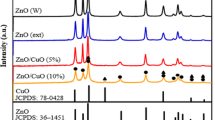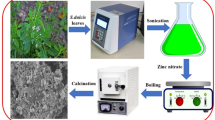Abstract
Antibacterial agent based on modification of Macaranga tanarius (M. tanarius) extract into CQDs@M. tanarius has been successfully synthesized and applied against Escherichia coli and Staphylococcus aureus. Macaranga tanarius plants were obtained from Buton Island, Southeast Sulawesi-Indonesia, and used as precursors for Carbon Quantum Dots (CQDs). In the synthesis, the dried leaves of M. tanarius were macerated, and then the filtrate was modified hydrothermally in a Teflon-lined stainless steel autoclave. The modification results produce nano-sized CQDs@M. tanarius particles. The PSA test confirmed this, which described the CQDs@M. tanarius particle size as 57.0 nm. The results of UV–Vis spectroscopy tests illustrate that the CQDs@M. tanarius molecules experience π → π* and n → π* electronic transitions at a wavelength of 367 nm. Meanwhile, in the FTIR spectroscopy test, stretching vibrations from the functional groups –OH, C–H, C=O, C–O, and the benzene ring were observed at wave numbers 3415.93 cm−1, 2976.16 cm−1, 1641.42 cm−1, 1274.95 cm−1, and 692.44 cm−1, respectively. Based on the antibacterial activity test, it is known that CQDs@M. tanarius has high inhibitory activity against E. coli and S. aureus. The resulting inhibition diameters are 15.82 mm and 11.24 mm, respectively. This high inhibitory diameter further illustrates the potential of CQDs@M. tanarius for its further application as an antibacterial material in the future.




Similar content being viewed by others
Data Availability
The datasets generated during and analyzed during the current study are available from the corresponding author upon reasonable request.
References
Pandiyan S, Arumugam L, Srirengan SP, Pitchan R, Sevugan P, Kannan K, Pitchan G, Hegde TA, Gandhirajan V (2020) Biocompatible carbon quantum dots derived from sugarcane industrial wastes for effective nonlinear optical behavior and antimicrobial activity applications. ACS Omega 5:30363–30372
Hao X, Huang L, Zhao C, Chen S, Lin W, Lin Y, Zhang L, Miao C, Lin X, Chen M (2021) Antibacterial activity of positively charged carbon quantum dots without detectable resistance for wound healing with mixed bacteria infection. Mater Sci Eng C 123:111971
W.H. Organization (2020) Global antimicrobial resistance surveillance system (GLASS) report: early implementation 2020
Rello J, Parisella FR, Perez A (2019) Alternatives to antibiotics in an era of difficult-to-treat resistance: new insights. Expert Rev Clin Pharmacol 12:635–642
Horky P, Skalickova S, Urbankova L, Baholet D, Kociova S, Bytesnikova Z, Kabourkova E, Lackova Z, Cernei N, Gagic M (2019) Zinc phosphate-based nanoparticles as a novel antibacterial agent: in vivo study on rats after dietary exposure. J Anim Sci Biotechnol 10:1–12
Hamad A, Khashan KS, Hadi A (2020) Silver nanoparticles and silver ions as potential antibacterial agents. J Inorg Organomet Polym Mater 30:4811–4828
Lakshmi SD, Avti PK, Hegde G (2018) Activated carbon nanoparticles from biowaste as new generation antimicrobial agents: a review. Nano-Struct Nano-Objects 16:306–321
Liu J, Li S, Fang Y, Zhu Z (2019) Boosting antibacterial activity with mesoporous silica nanoparticles supported silver nanoclusters. J Colloid Interface Sci 555:470–479
Zhao Y, Jiang X (2013) Multiple strategies to activate gold nanoparticles as antibiotics. Nanoscale 5:8340–8350
Wang L, Li S, Yin J, Yang J, Li Q, Zheng W, Liu S, Jiang X (2020) The density of surface coating can contribute to different antibacterial activities of gold nanoparticles. Nano Lett 20:5036–5042
Sathiyaraj S, Suriyakala G, Gandhi AD, Babujanarthanam R, Almaary KS, Chen T-W, Kaviyarasu K (2021) Biosynthesis, characterization, and antibacterial activity of gold nanoparticles. J Infect Public Health 14:1842–1847
Žalnėravičius R, Klimas V, Paškevičius A, Grincienė G, Karpicz R, Jagminas A, Ramanavičius A (2021) Highly efficient antimicrobial agents based on sulfur-enriched, hydrophilic molybdenum disulfide nano/microparticles and coatings functionalized with palladium nanoparticles. J Colloid Interface Sci 591:115–128
Bhattacharjee D, Sheet SK, Khatua S, Biswas K, Joshi S, Myrboh B (2018) A reusable magnetic nickel nanoparticle based catalyst for the aqueous synthesis of diverse heterocycles and their evaluation as potential anti-bacterial agent. Bioorg Med Chem 26:5018–5028
Ahghari MR, Soltaninejad V, Maleki A (2020) Synthesis of nickel nanoparticles by a green and convenient method as a magnetic mirror with antibacterial activities. Sci Rep 10:12627
Natsir M, Maulidiyah M, Ansharullah A, Arham Z, Wibowo D, Nurdin M (2018) Natural biopesticide preparation as antimicrobial material based on lignin photodegradation using mineral ilmenite (Feo. Tio2). Int Res J Pharm 9:170–174
Maulidiyah M, Susilowati PE, Mudhafar NK, Salim LA, Wibowo D, Muzakkar MZ, Irwan I, Arham Z, Nurdin M (2022) Photo-inactivation Staphylococcus aureus by using formulation of Mn-N-TiO2 composite coated wall paint. Biointerface Res Appl Chem 12:1628–1637
Nurdin M, Watoni AH, Arham Z, Yanti NA, Marlini S, Maulidiyah M, Salim LOA, Irwan I (2022) Strong inhibition of silver-doped TiO2 nanoparticles against P. palmivora in visible light. Bionanoscience 12:351–358
Zhang R, Carlsson F, Edman M, Hummelgård M, Jonsson B, Bylund D, Olin H (2018) Escherichia coli bacteria develop adaptive resistance to antibacterial ZnO nanoparticles. Adv Biosyst 2:1800019
Sirelkhatim A, Mahmud S, Seeni A, Kaus NHM, Ann LC, Bakhori SKM, Hasan H, Mohamad D (2015) Review on zinc oxide nanoparticles: antibacterial activity and toxicity mechanism. Nano-Micro Lett 7:219–242
Gudkov SV, Burmistrov DE, Serov DA, Rebezov MB, Semenova AA, Lisitsyn AB (2021) A mini review of antibacterial properties of ZnO nanoparticles. Front Phys 9:641481
Shen W, Li P, Feng H, Ge Y, Liu Z, Feng L (2017) The bactericidal mechanism of action against Staphylococcus aureus for AgO nanoparticles. Mater Sci Eng C 75:610–619
Lekshmi GS, Tamilselvi R, Geethalakshmi R, Kirupha SD, Bazaka O, Levchenko I, Bazaka K, Mandhakini M (2022) Multifunctional oil-produced reduced graphene oxide–silver oxide composites with photocatalytic, antioxidant, and antibacterial activities. J Colloid Interface Sci 608:294–305
Tomina VV, Furtat IM, Lebed AP, Kotsyuda SS, Kolev H, Kanuchova M, Behunova DM, Vaclavikova M, Melnyk IV (2020) Diverse pathway to obtain antibacterial and antifungal agents based on silica particles functionalized by amino and phenyl groups with Cu (II) ion complexes. ACS Omega 5:15290–15300
Kunkalekar RK (2019) Role of oxides (Fe3O4, MnO2) in the antibacterial action of Ag–metal oxide hybrid nanoparticles. In: Noble Met. Oxide Hybrid Nanoparticles, Elsevier. pp. 303–312
Jia H, Zhang X, Zeng X, Cai R, Wang Z, Yuan Y, Yue T (2021) Construction of silver nanoparticles anchored flower-like magnetic Fe3O4@ SiO2@ MnO2 hybrids with antibacterial and wound healing activity. Appl Surf Sci 567:150797
Naz S, Gul A, Zia M, Javed R (2023) Synthesis, biomedical applications, and toxicity of CuO nanoparticles. Appl Microbiol Biotechnol 107:1039–1061
Mustafa YF (2023) Modern developments in the application and function of metal/metal oxide nanocomposite-based antibacterial agents. Bionanoscience 13:840–852
Mašojević D, Stamenović U, Otoničar M, Davidović S, Škapin S, Barudžija T, Vodnik V (2023) Evaluation of the antibacterial effectiveness of novel copper/polypyrrole nanocomposite. Mater Lett 338:134051
Paunova-Krasteva T, Hemdan BA, Dimitrova PD, Damyanova T, El-Feky AM, Elbatanony MM, Stoitsova S, El-Liethy MA, El-Taweel GE, El Nahrawy AM (2023) Hybrid chitosan/CaO-based nanocomposites doped with plant extracts from Azadirachta indica and Melia azedarach: evaluation of antibacterial and antibiofilm activities. Bionanoscience 13:88–102
Yang S-R, Wang R, Yan C-J, Lin Y-Y, Yeh Y-J, Yeh Y-Y, Yeh Y-C (2023) Ultrasonic interfacial crosslinking of TiO2-based nanocomposite hydrogels through thiol–norbornene reactions for sonodynamic antibacterial treatment. Biomater Sci 11:4184–4199
Soleimani S, Yousefzadi M, Jannesari A, Ghaderi A, Shahdadi A (2023) Green synthesis of graphene oxide-based nanocomposite by Polycladia myrica: antibacterial, anti-algae, and acute zooplanktonic responses. J Appl Phycol. https://doi.org/10.1007/s10811-023-02951-y
Liu G, Shi K, Sun H (2023) Research progress in hemicellulose-based nanocomposite film as food packaging. Polymers 15:979
Zhang Y, Li P, Yan H, Guo Q, Xu Q, Su W (2023) Green synthesis and multifunctional applications of nitrogen-doped carbon quantum dots via one-step hydrothermal carbonization of Curcuma zedoaria. Anal Bioanal Chem 415:1917–1931
Wen F, Li P, Yan H, Su W (2023) Turmeric carbon quantum dots enhanced chitosan nanocomposite films based on photodynamic inactivation technology for antibacterial food packaging. Carbohydr Polym 311:120784
Alamdari NG, Almasi H, Moradi M, Akhgari M (2023) Characterization of carbon quantum dots synthesized from vinasse and date seeds as agro-industrial wastes. Waste and Biomass Valorization. 1–15
Nammahachak N, Aup-Ngoen KK, Asanithi P, Horpratum M, Chuangchote S, Ratanaphan S, Surareungchai W (2022) Hydrothermal synthesis of carbon quantum dots with size tunability via heterogeneous nucleation. RSC Adv 12:31729–31733
Wei X, Cheng F, Yao Y, Yi X, Wei B, Li H, Wu Y, He J (2021) Facile synthesis of a carbon dots and silver nanoparticles (CDs/AgNPs) composite for antibacterial application. RSC Adv 11:18417–18422
Liu T, Pang Q, Mai K, He X, Xu L, Zhou F, Liu Y (2022) Silver nanoparticle@carbon quantum dot composite as an antibacterial agent. RSC Adv 12:9621–9627
Nasseri MA, Keshtkar H, Kazemnejadi M, Allahresani A (2020) Phytochemical properties and antioxidant activity of Echinops persicus plant extract: green synthesis of carbon quantum dots from the plant extract. SN Appl Sci 2:1–12
Gedda G, Sankaranarayanan SA, Putta CL, Gudimella KK, Rengan AK, Girma WM (2023) Green synthesis of multi-functional carbon dots from medicinal plant leaves for antimicrobial, antioxidant, and bioimaging applications. Sci Rep 13:6371
Surendran P, Lakshmanan A, Priya SS, Geetha P, Rameshkumar P, Kannan K, Hegde TA, Vinitha G (2021) Fluorescent carbon quantum dots from Ananas comosus waste peels: a promising material for NLO behaviour, antibacterial, and antioxidant activities. Inorg Chem Commun 124:108397
Velmurugan P, Kumar RV, Sivakumar S, Ravi AV (2022) Fabrication of blue fluorescent carbon quantum dots using green carbon precursor Psidium guajava leaf extract and its application in water treatment. Carbon Lett 32:119–129
Chien Y-H, Yu Y-H, Ye S-R, Chen Y-W (2022) Antibacterial and antioxidant activity of the fruit of Macaranga tanarius, the plant origin of Taiwanese green Propolis. Antioxidants 11:1242
Lee J-H, Kim Y-G, Khadke SK, Yamano A, Woo J-T, Lee J (2019) Antimicrobial and antibiofilm activities of prenylated flavanones from Macaranga tanarius. Phytomedicine 63:153033
Lim TY, Lim YY, Yule CM (2009) Evaluation of antioxidant, antibacterial and anti-tyrosinase activities of four Macaranga species. Food Chem 114:594–599
Arham Z, Kurniawan K, Anhusadar L (2023) High electrochemical response of TiO2@C-dots nanocomposites as electrode modifiers for Pb (II) detection. Mater Sci Semicond Process 160:107466
Roomi AB, Widjaja G, Savitri D, Turki Jalil A, Fakri Mustafa Y, Thangavelu L, Kazhibayeva G, Suksatan W, Chupradit S, Aravindhan S (2021) SnO2: Au/carbon quantum dots nanocomposites: synthesis, characterization, and antibacterial activity. J. Nanostruct 11:514–523
Safardoust-Hojaghan H, Salavati-Niasari M, Amiri O, Rashki S, Ashrafi M (2021) Green synthesis, characterization and antimicrobial activity of carbon quantum dots-decorated ZnO nanoparticles. Ceram Int 47:5187–5197
Travlou NA, Giannakoudakis DA, Algarra M, Labella AM, Rodríguez-Castellón E, Bandosz TJ (2018) S-and N-doped carbon quantum dots: surface chemistry dependent antibacterial activity. Carbon NY 135:104–111
Acknowledgements
We acknowledge the financial support from the Ministry of Education, Culture, Research and Technology of the Republic of Indonesia under the Fundamental Research award grant no 16/E5/PG.02.00.PL/2023 and 950/UN56.D.01/PN.03.00/2023.
Author information
Authors and Affiliations
Contributions
SS: Writing-original draft, investigation, formal analysis, data curation, conceptualization. DT: Formal analysis, validation, conceptualization. AA: Formal analysis, Validation. ZA: Writing-original draft, validation, data curation, writing-review and editing.
Corresponding authors
Ethics declarations
Conflict of interest
Saparuddin Saparuddin declares that he has no conflict of interest. Djunarlin Tojang declares that she has no conflict of interest. Alimuddin Alimuddin declares that he has no conflict of interest. Zul Arham declares that he has no conflict of interest.
Ethical Approval
This study does not contain experiments that involve humans or animals other than the authors who performed the work.
Consent to Participate
Not applicable.
Consent for Publication
The manuscript in full has not been published anywhere.
Additional information
Publisher's Note
Springer Nature remains neutral with regard to jurisdictional claims in published maps and institutional affiliations.
Rights and permissions
Springer Nature or its licensor (e.g. a society or other partner) holds exclusive rights to this article under a publishing agreement with the author(s) or other rightsholder(s); author self-archiving of the accepted manuscript version of this article is solely governed by the terms of such publishing agreement and applicable law.
About this article
Cite this article
Saparuddin, S., Tojang, D., Alimuddin, A. et al. High Inhibition Activity of CQDs-Macaranga tanarius Organic Framework Nanomaterial-Based Antibacterials. Indian J Microbiol (2024). https://doi.org/10.1007/s12088-024-01230-9
Received:
Accepted:
Published:
DOI: https://doi.org/10.1007/s12088-024-01230-9




